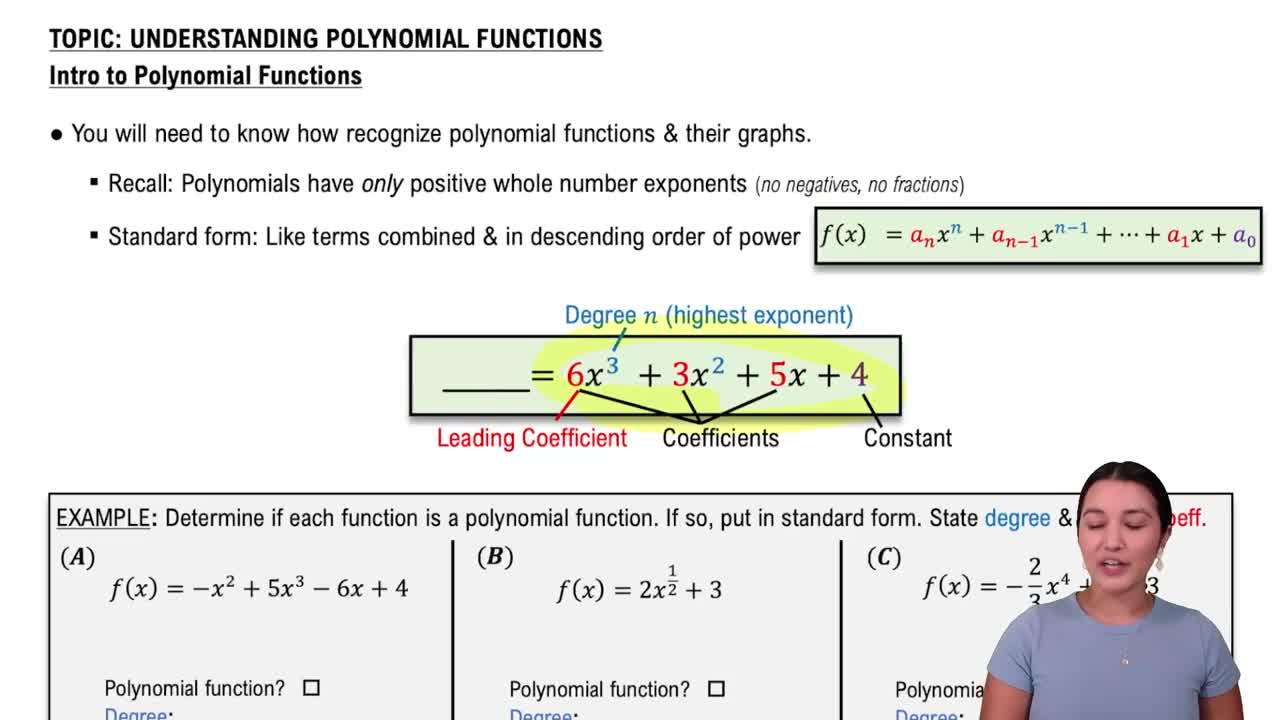Table of contents
- 0. Review of Algebra4h 16m
- 1. Equations & Inequalities3h 18m
- 2. Graphs of Equations43m
- 3. Functions2h 17m
- 4. Polynomial Functions1h 44m
- 5. Rational Functions1h 23m
- 6. Exponential & Logarithmic Functions2h 28m
- 7. Systems of Equations & Matrices4h 6m
- 8. Conic Sections2h 23m
- 9. Sequences, Series, & Induction1h 19m
- 10. Combinatorics & Probability1h 45m
9. Sequences, Series, & Induction
Sequences
Problem 21b
Textbook Question
In Exercises 11–24, use mathematical induction to prove that each statement is true for every positive integer n. 1 · 2 + 2 · 3 + 3 · 4 + ... + n(n + 1) = n(n + 1)(n + 2)/3
 Verified step by step guidance
Verified step by step guidance1
**Step 1: Base Case** - Verify the statement for the initial value, usually n = 1. Substitute n = 1 into both sides of the equation to check if they are equal.
**Step 2: Inductive Hypothesis** - Assume the statement is true for some positive integer k, i.e., assume 1 \cdot 2 + 2 \cdot 3 + 3 \cdot 4 + \ldots + k(k + 1) = \frac{k(k + 1)(k + 2)}{3}.
**Step 3: Inductive Step** - Prove the statement is true for n = k + 1. Start by adding the next term (k + 1)(k + 2) to both sides of the inductive hypothesis.
**Step 4: Simplify the Expression** - Simplify the right-hand side of the equation after adding the term (k + 1)(k + 2) to the inductive hypothesis. Show that it equals \frac{(k + 1)(k + 2)(k + 3)}{3}.
**Step 5: Conclusion** - Since the base case holds and the inductive step is proven, conclude that the statement is true for all positive integers n by the principle of mathematical induction.
Recommended similar problem, with video answer:
 Verified Solution
Verified SolutionThis video solution was recommended by our tutors as helpful for the problem above
Video duration:
7mPlay a video:
Was this helpful?
Key Concepts
Here are the essential concepts you must grasp in order to answer the question correctly.
Mathematical Induction
Mathematical induction is a proof technique used to establish the truth of an infinite sequence of statements. It involves two main steps: the base case, where the statement is verified for the initial value (usually n=1), and the inductive step, where one assumes the statement holds for n=k and then proves it for n=k+1. This method is particularly useful for proving formulas involving integers.
Recommended video:
Guided course

Types of Slope
Summation of Series
The summation of series involves adding a sequence of numbers according to a specific rule. In this case, the series is formed by the products of consecutive integers, represented as n(n + 1). Understanding how to manipulate and simplify these sums is crucial for proving the given statement using induction.
Recommended video:

Geometries from Conic Sections
Polynomial Functions
Polynomial functions are expressions that involve variables raised to whole number powers, combined using addition, subtraction, and multiplication. The expression n(n + 1)(n + 2)/3 is a polynomial function of degree three. Recognizing the structure of polynomial functions helps in understanding their behavior and in performing algebraic manipulations necessary for proofs.
Recommended video:

Introduction to Polynomial Functions

 8:22m
8:22mWatch next
Master Introduction to Sequences with a bite sized video explanation from Patrick Ford
Start learningRelated Videos
Related Practice








